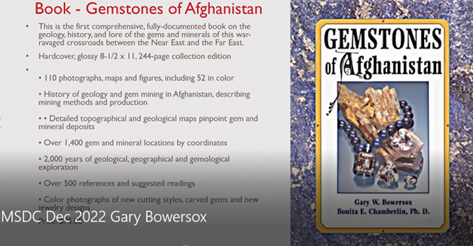Gem Hunting in Afghanistan and Central Asia
Synopsis of the December Program presented by Gary W. Bowersox
by Andy Thompson, MSDC Secretary
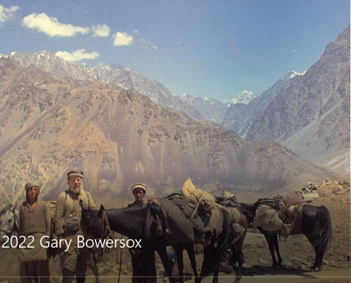
Cindy Schmidtlein introduced Gary Bowersox as an international mineral collector, dealer, and gem hunter who has devoted 50 years of his life to travel and research focusing on the mines and gemstones of Afghanistan. He also serves as president of Gem Hunters Corporation and has produced numerous interesting videos and articles.
Throughout his five decades and continuing today, Gary has climbed the mountains throughout the “stan” nations (Tajikistan, etc.), built lasting relationships, and led international seminars. He has also directly supported the miners of Afghanistan and promoted the welfare and education of its people. Gary explained that three days after graduating from college he began his world-wide travels, “bummed my way around the world and have not really stopped.”

Gary returned from a visit to Tajikistan in October 2021 and began his presentation by providing an overview of what has been happening with the Taliban’s sudden military takeover of Afghanistan in 2021. That event coincided with concluding his 50th year of traveling and gem hunting in the region. The Taliban takeover also temporarily closed the door to foreigners’ safe travel in Afghanistan.
In 2021, Gary said that said had been working to coordinate a large international symposium to be held in July of that year in Afghanistan. Its purpose was to allow international mineral dealers to gain access to and purchase $30 million worth of emeralds, rubies, lapis, and other gems that the Afghanistan Ministry of Mining had recently officially released for sale.
However, due to the Taliban takeover of the country on August 15, 2021, the location of the symposium was moved to Dubai and further postponed due to additional geopolitical and Covid complications. But just this week, Gary said, he was rehired by USAID to go forward with a smaller international conference to figure out, given this rapidly changing international scene, how other nations can support the Afghanistan miners via the international sales of its gemstones.
To provide his MSDC listeners with context, he showed the following map which shows the location of Afghanistan and its neighbors. The blue line starting in Tajikistan traces a frequently used pathway for entering Afghanistan and exporting its gems for sale in Pakistan’s capital, Islamabad.

A History Replete with Invaders
Gary reminded his audience of the many ancient and current invaders who, for over 3,000 years, have come to Afghanistan to carry off its mineral resources. He cited the Egyptian King Tutankhamun’s famous gold and lapis death mask dating back to 1,300 years BC as typical of the royal family’s extensive and consistent use of this treasured Afghan blue mineral.
Subsequent leaders and nations sent their invading armies to continue the plundering. Gary provided the following short list of the most prominent conquerors and nations who invaded Afghanistan over the last two millennia.
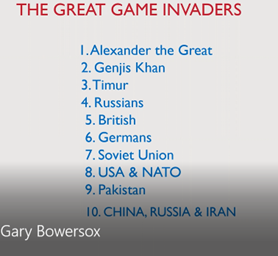
The Minerals of Afghanistan
What is the appeal that draws empires, nations, and mineral collectors to Afghanistan? The photo below shows some of the gems Gary has been buying, with about 85% having come from Afghanistan.
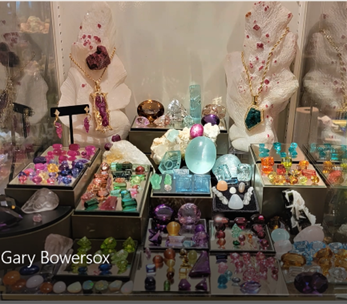
The beauty and diversity of the above gems are obvious, but hidden are the struggles of traveling to their host mines. Typically, the minerals are extracted from extremely difficult landscapes. “They (the Afghans) have twenty some mountains which are between 15 and 18 thousand feet high and that’s the most difficult part of traveling through the county” and collecting there.
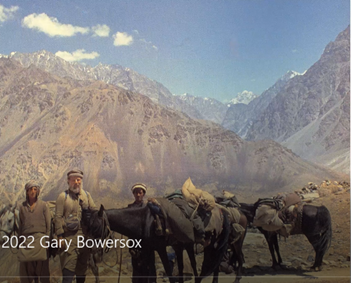
Kunzite
Gary, shown below wearing a turban, spent years climbing these mountains to get to the mining areas. But often he met with local miners as together they negotiated trades and sales of their pale violet colored kunzite. “I always used translators” he said, “because if you spoke several languages, the local people believed you were probably a trained spy and they would not work with you.”
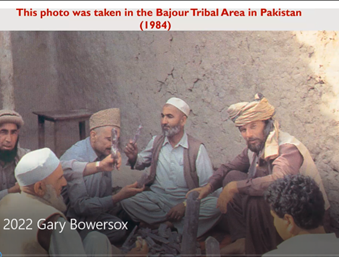
How Invading Soviets Mistakenly Financed Afghan’s Resistance
In 1979, during Gary’s work in Afghanistan, the Soviet Union’s invading army attempted to take over the countryside then ruled by the independent mujahideen. Although war tends to destroy all local productivity, the resilient Afghan miners turned it to their advantage.
Want to learn how Soviet choppers inadvertently supported Afghanistan miners with an increase in emeralds? Go to the video link at the end of this report and see Gary’s explanation. The presentation is packed with intriguing stories, mineralogical history, and current international events.
International Support for Afghanistan’s Gem Miners
If you want to learn about the diverse ways the international community used technology and worked to help organize the Afghan miners and their industry, go to the video below. One effort included a survey to determine exactly how many of each type of mine was still in production. As an example, here is an overview of the emerald mines found across the country.
Emeralds
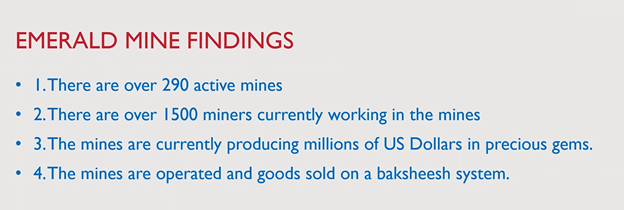
Sometimes documenting the mines was facilitated by personal visits. In one such visit, Gary, who had just turned 82, had to walk up to the 13,000-foot level to visit the Khenj emerald mine. Roads to the vast majority of the mines can be navigated only by horses, not trucks. As a result, the use of industrial-scale equipment is not possible and most mining is by hand.
A problem Gary faced in getting to the Khenj emerald mine was finding a suitable horse. Afghans typically ride bareback, without saddles and stirrups, which posed a further challenge. Gary noted that such travel is a young rider’s game and given the steep nature of the path, it proved not to be a good match between the horse and Gary’s knees.
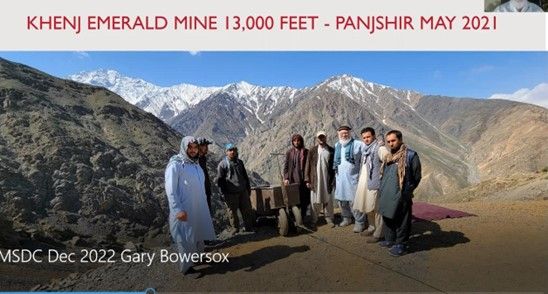
Another example of international support for the Afghan people is provided in the satellite image below. Funded by the World Bank, the hyperspectral imagery shows colors that illustrate the diverse chemical composition of the soil. Gary and colleagues were not allowed to have access to that analysis. But he thought it would be helpful in identifying the location of beryllium deposits because that element is what gives emeralds its brilliant green color.
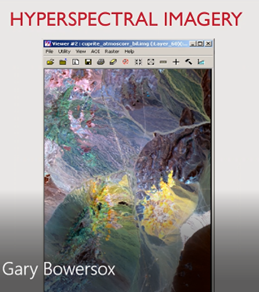
The quality of Afghan emeralds (a gemstone containing beryllium), Gary said, is on a par with those from Columbia. One difference between the two is that the Afghan emeralds sometimes are much larger, over 100 carats.
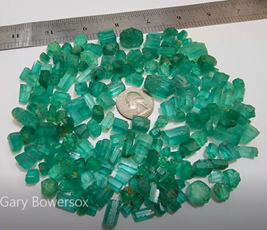
Rubies
Along with lapis and emeralds, Afghanistan is famous for its rubies.
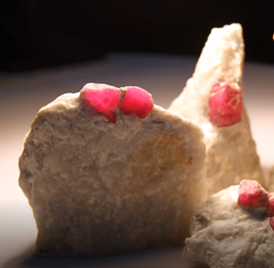
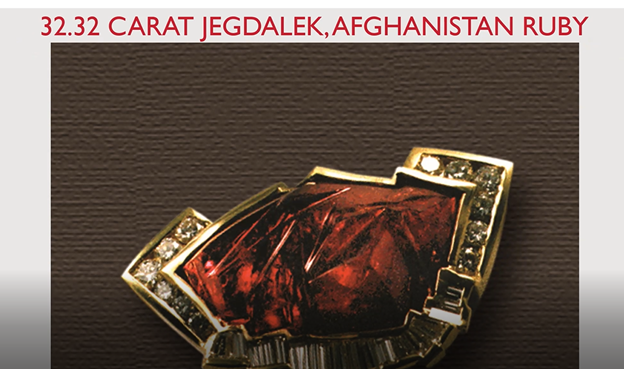
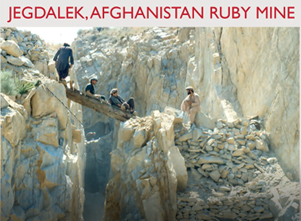
Go to Gary’s website if interested in reading an article he coauthored with colleagues “Ruby Mines, Jegdalek, Afghanistan” concerning ruby and sapphire mining. The article is available on Gary’s website, listed at the end of this summary of his talk.
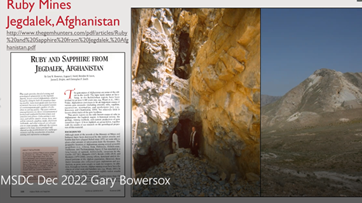
Helping Afghans Modernize Their Mining Industry
Gary explained one way he and colleagues are helping the Afghan mining industry modernize is to provide them with high-level technology about the locations of their mines and mineral resources. More precise maps of the mines and their respective minerals is one story in itself. But even more promising is the satellite imagery, such as the hyperspectral imagery shown earlier, and the example shown below, which can help connect the geological dots throughout the country.
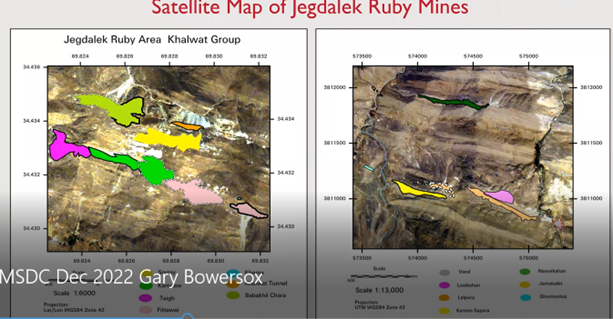
To learn the significance of the satellite maps, be sure to listen to Gary’s entire talk. The link for Gary’s talk is found at the end of this article and it takes you to the MSDC YouTube channel, the site of over a dozen presentations to the club.
Tourmaline
This valley in Nuristan, Afghanistan is where Alexander the Great and his army passed through and encountered very strong local wine and poison ivy. History shows that Alexander did not come here for the tourmaline.
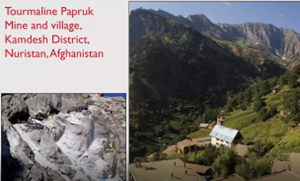
Aquamarine
The extraordinary size and beauty of Gary’s cabochon aquamarine, pictured below, close to 600 carats, would be the envy of every world class museum.
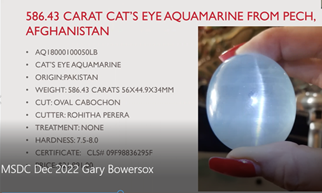
Throughout Gary’s talk, he described the past and current politics of Afghanistan and its neighbors. He noted, for example, how the Chinese have an increasingly strong presence in Tajikistan and 35% of the country’s debt is to China. They have a strong presence on local TV, speaking perfect English, telling the people how Russia, the U.S., and Ukraine are killing people while the Chinese are economically supporting the people of Tajikistan. The propaganda does not mention the Chinese tactic is to create increasing dependency on China.
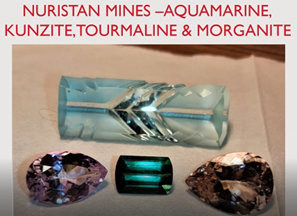
Lapis Lazuli
Gary provided a short overview of the history of lapis mining and its uses by Egyptian royalty.
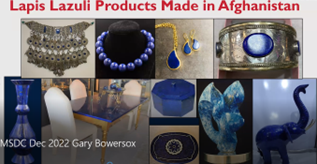
Earlier in his career, Gary worked with the Getty Museum (in Los Angeles, CA) which has been researching from which mine or mines the renaissance painters such as Michelangelo obtained the lapis mineral for making their azure blue paint. Of course, Gary has been visiting lapis mines for decades.
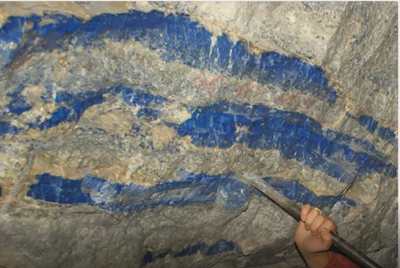
For Afghan Gemstones, No End In Sight
Afghanistan’s Sar-E-Sang (a.k.a. Sar A Sang) Valley has been the go-to site for mining lapis lazuli since the time of the Egyptians. As indicated on the photo below, besides lapis, the valley has also yielded other precious gems. Gary added: “This photo taken just last week shows a new site for mining spinel half way up the mountains.”
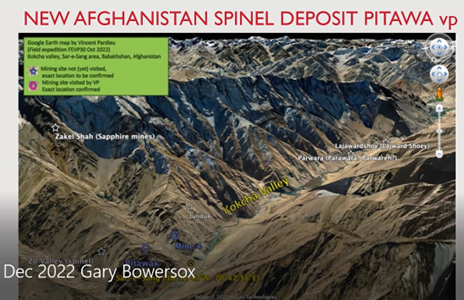
Gary noted that even though this valley in the Sar-E-Sang region has been famous for thousands of years, miners have just discovered a new spinel deposit.
Spinel
The gems shown below have been mined in just the last six months.
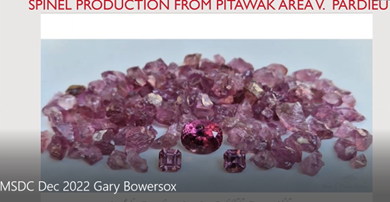
Don't Miss MSDC's Video of the Presentation
The MSDC YouTube video of Gary’s presentation has many more interesting stories, including:
● gaining a Queen’s access to a rare photograph
● wartime Soviet missile strikes that increased Afghan miners’ wealth
● Alexander the Great’s famous Bucephalus steed etched in emerald
● an available inexpensive high-rise condo in Hawaii
● his assessment of the current and future stability of Afghanistan
● answers to MSDC members’ and guests’ follow up questions.
To view Gary Bowersox’s full MSDC presentation (113 minutes including Q&A), you can visit MSDC's YouTube website where you can find Gary's December presentation, as well as 12 previously recorded programs. If you want to be notified each time a new MSDC monthly program video becomes available, click on the “subscribe” button. Thank you for your interest in MSDC programs.
To learn more about Gary’s company and newsletter, or to purchase a gemstone, jewelry, or an art object, go to: www.thegemhunters.com.
In particular, see a professionally made video (58 minutes) of Gary’s mineral hunting which is available at: Gemstone Hunting in Afghanistan and Central Asia – Gary Bowersox - YouTube.
